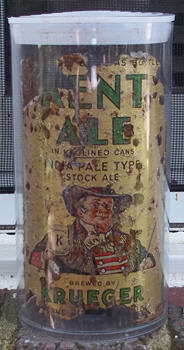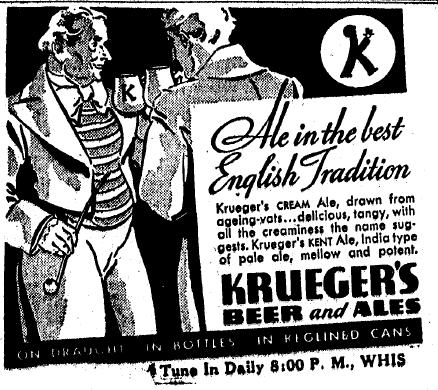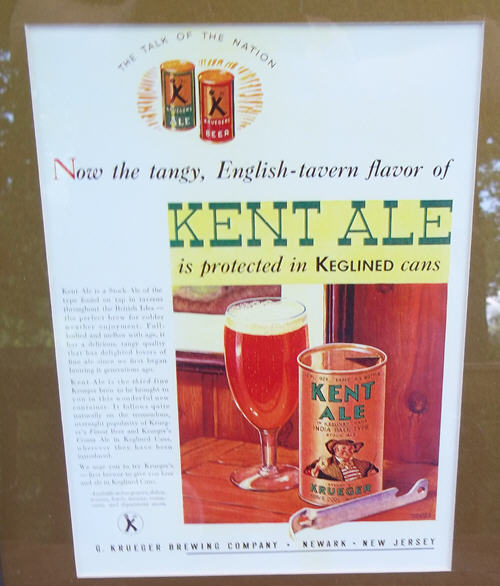Kent Ale: 1935-1936, 1938
 |
This is my 100th Can-of-the-Month (COM) and I wanted to pick a special can. My Kent Ale is one of my very favorite cans, so here it is. Well, here is the half of the can that still exists. Matt M. found several in Maine in what he called "The Gatekeeper's Dump" and gave me this one.
Kent Ale was made by Krueger Brewing. In 1935 Krueger was the first brewery to put their product in cans and it was such a success that they quickly decided to add to their existing lineup of Krueger Ale and Krueger Beer. Kent Ale was not one of their flagship brands, but it must have seemed to be a good choice.
 |
Ad from a West Virginia newspaper, January 28, 1936. |
According to the most popular account, Kent Ale in cans did not sell well. Ale was already less popular than beer in the US, except for in New England, and selling two ale products in cans (Krueger Ale and Kent) must have seen like a waste of resources to Krueger. They discontinued the cans in 1936 to devote their canning lines to Krueger Ale, Beer and, in Spring, their Krueger Bock.
 |
| A color Krueger advertisement. it wa professionally framed so I don't want to try and remove it to check the date, but it's probably mid 1935. |
Or did they? As beer cans were developed they changed. Canning companies used thinner metal, changed the seams, and changed the lids. kent cans have been found with the types of lids used after 1936. Several collectors have suggested that Krueger didn't want to waste all the Kent Ale cans they had purchased in 1935, so in 1938 they filled a batch of Kent cans for sale somewhere. Why? Perhaps they had a small gap in their canning schedule. After all, they didn't stop brewing Kent Ale, it was still sold in bottles and on tap, so why not can a batch when they had the time.
Kent Cans
Kent Ale cans are fairly rare and highly desirable, which is why I'm happy to have just the front part of one! A number of them have been dumped in Maine and a couple of very nice ones were found under the floor of an old house in Georgia in the 1980s. Theoretically they should be found in every state that sold Krueger products, which is the east coast of the US from Maine through Georgia as well as West Virginia.
IPA's
(This section is largely taken from Wikipedia's article on India Pale Ale.) IPA's, India Pale Ale, IPA descends from the earliest pale ales of the 17th century. The term "pale ale" originally denoted an ale which had been brewed from pale malt. The pale ales of the early 18th century were lightly hopped and quite different from later pale ales. By the mid-18th century, pale ale was mostly manufactured with coke-fired malt, which produced less smoking and roasting of barley in the malting process, and hence produced a paler beer. One such variety of beer was October beer, a pale well-hopped brew popular among the landed classes, who brewed it domestically; once brewed it was intended to cellar two years.
Among the earliest known named brewers whose beers were exported to India was George Hodgson of the Bow Brewery, on the Middlesex-Essex border. Bow Brewery beers became popular among East India Company traders in the late 18th century because of the brewery's location and Hodgson's liberal credit line of 18 months. East Indiamen transported a number of Hodgson's beers to India, among them his October beer, which benefited exceptionally from conditions of the voyage and was apparently highly regarded among consumers in India. Bow Brewery came into control of Hodgson's sons in the early 19th century, but their business practices alienated their customers. During the same period, several Burton breweries lost their European export market in Russia because of new tariffs on beer, and were seeking a new export market for their beer.
Demand for the export style of pale ale, which had become known as "India Pale Ale," developed in England around 1840 and India Pale Ale became a popular product in England. Some brewers dropped the term "India" in the late 19th century, but records indicated that these "pale ales" retained the features of earlier IPA. American, Australian and Canadian brewers manufactured beer with the label IPA before 1900, and records suggest that these beers were similar to English IPA of the era.
Sources Used
BeerCanHistory.com (accessed 8/1/2011)
Keglined.com (access 8/1/2011)
